Wyvern
A wyvern (/ˈwaɪvərn/ WY-vərn, sometimes spelled wivern) is a legendary bipedal dragon[1] with a tail often ending in a diamond- or arrow-shaped tip.
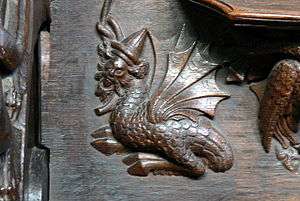
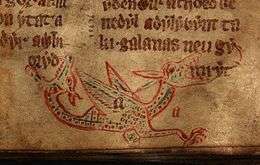
The wyvern in its various forms is important to heraldry, frequently appearing as a mascot of schools and athletic teams (chiefly in the United States, United Kingdom, and Canada). It is a popular creature in European literature, video games, and modern fantasy. The wyvern in heraldry and folklore is rarely fire-breathing like the four-legged dragon. Sometimes modern fantasy book and media authors portray wyverns that are frost-breathing or poison-breathing instead of fire-breathing.
Etymology
The current spelling wyvern is not attested before the seventeenth century as "winged two-footed dragon".[2] According to the Oxford English Dictionary, it is an alteration of Middle English wyver (attested thirteenth century), from Anglo-French wivre (cf. French guivre and vouivre), which originate from Latin vīpera, meaning "viper", "adder", or "asp".[2][3] Conversely, medievalist William Sayers proposes a more complex origin for the term. He notes that the Anglo-French guivre and its Middle English derivative ceased to retain the original sense of "venomous snake" after the Latin term was re-introduced into medieval Latin, freeing them up to take an alternate meaning.[4]:460 Adducing another meaning of wiver (this time Old English) and guivre, "light javelin",[4]:461 and noting partial resemblances between the size and shape of javelins and snakes,[4]:462 plus the later medieval era's increasing use of heavy armor and decreasing use of light javelins, he proposes that the concepts of "venomous snake" and "light javelin" were melded to produce a new term for a previously unimagined concept of flying snake, a kind of dragon.[4]:463
History
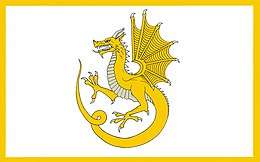
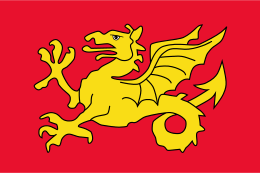
The design of the wyvern is thought to have derived from the figure of the dragon encountered by Trajan's legions in Dacia. It may be the origin of the red dragon of Wales and the golden dragon of the Kingdom of Wessex carried at the Battle of Burford in AD 752.[5]
The depiction of dragons representing Wales goes back centuries; as seen in Geoffrey of Monmouth's Historia Regum Britanniae, when depicting Merlin's prophecy of the red dragon of Wales beating the white Anglo-Saxon dragon, they are seen to have two legs rather than the modern four legs that the current Welsh dragon possesses.[6] Since the 4th century, Welsh Kings and princes have carried with them this depiction of a dragon, each ruler changing its appearance from a Wyvern to a four-legged dragon.
The concept of winged snakes is common in cultures around the Mediterranean, with a notable example being the Egyptian goddess Wadjet.[7] The oldest creatures outright referred to as "winged dragons" are Helios's chariot steeds, which aid Medea.
Distinction from dragons
Wyverns are very similar to dragons, and in many languages, cultures and contexts no clear distinction is made between the two. Since the sixteenth century, in English, Scottish, and Irish heraldry, the key difference has been that a wyvern has two legs, whereas a dragon has four. However, this distinction is not commonly observed in the heraldry of other European countries, where two-legged dragon-like creatures being called dragons is entirely acceptable.[8]
In modern fiction
In the modern fantasy genre, there is little differentiation between dragons and wyverns, with two-legged magical reptilian creatures all likely to be referred to as "dragons" without any differentiation between types. Wyverns, when present as creatures distinct from dragons, tend to appear as less magical and more as dangerous beasts: smaller, weaker, and less intelligent than dragons. While a fantasy dragon often has a breath weapon, such as fire, wyverns rarely have such abilities and are more feared for their ferocity and sharp teeth and claws. Wyverns are sometimes associated with poison, either in the form of venomous fangs or tail barb, or poisonous breath, but this trait is not universally represented and may be a more recent addition to the lore based on the gila monster.[9]
The wyvern frequently features in modern fantasy fiction, though its first literary appearances may have been in medieval bestiaries.[10]
In heraldry
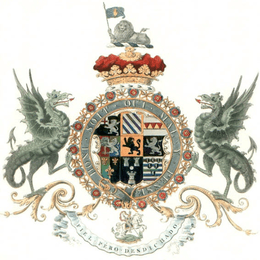
The wyvern is a frequent charge in English heraldry and vexillology, also occasionally appearing as a supporter or crest.
A wyvern is typically depicted resting upon its legs and tail, but may be depicted with its claws in the air and only supported by its tail. On occasion, a wyvern may be depicted as wingless and with its tail nowed.[11]
A white (Argent) wyvern formed the crest of the Borough of Leicester as recorded at the heraldic visitation of Leicestershire in 1619: "A wyvern sans legs argent strewed with wounds gules, wings expanded ermine." The term "sans legs" may not imply that the wyvern was "without legs", rather than its legs are not depicted, being hidden or folded under.[12] This was adopted by the Midland Railway in 1845 when it became the crest of its unofficial coat of arms.[13] The company asserted that the "wyvern was the standard of the Kingdom of Mercia", and that it was "a quartering in the town arms of Leicester".[14] However, in 1897 the Railway Magazine noted that there appeared "to be no foundation that the wyvern was associated with the Kingdom of Mercia".[15] It has been associated with Leicester since the time of Thomas, 2nd Earl of Lancaster and Leicester (c. 1278–1322), the most powerful lord in the Midlands, who used it as his personal crest.[16]
A green Wyvern stands in the emblem of the ancient and historical Umbrian city of Terni, the dragon is called by the citizens with the name of Thyrus. A sable wyvern on a white background with endorsed wings forms the coat of arms of the Tilley family.
The arms of the Worshipful Society of Apothecaries depict a wyvern, symbolising disease, being overcome by Apollo, symbolising medicine.
As a logo or mascot
The wyvern is also a fairly popular commercial logo or mascot, especially in Wales and what was once the West Country Kingdom of Wessex, but also farther afield in Herefordshire and Worcestershire, as the rivers Wye and Severn run through Hereford and Worcester respectively. A local radio station was formerly called Wyvern FM. Vauxhall Motors had a model in its range in the 1950s called the Wyvern. The Westland Wyvern was a British single-seat carrier-based multi-role strike aircraft built by Westland Aircraft that served in the 1950s, seeing active service in the 1956 Suez Crisis.
The wyvern is a frequent mascot of athletic teams, colleges and universities, particularly in the United Kingdom and the United States, and is the mascot of the Korea Baseball Organization team SK Wyverns, established in 2000, King's College, within the University of Queensland, and the Japanese basketball team, the Passlab Yamagata Wyverns of the Japanese B.League
The wyvern is also the mascot of the 51st Operations Support Squadron at Osan Air Base, with the motto: "breathin' fire!"[17]
A wyvern is depicted on the unit crest of the USAF 31st Fighter Wing.
A wyvern is featured on the club crests of both Leyton Orient F.C. and Carlisle United F.C.
A wyvern is featured as the team mascot for Woodbridge College in Woodbridge, Ontario, Canada.
A wyvern is the mascot of Quinsigamond Community College in Worcester, Massachusetts.
A wyvern is the logo of LLVM the compiler infrastructure project.
Wyvern is the a nickname of a fictional aircraft in the Ace Combat series: the X-02 Wyvern.
Examples
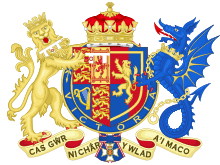 Arms of Sophie, Countess of Wessex
Arms of Sophie, Countess of Wessex
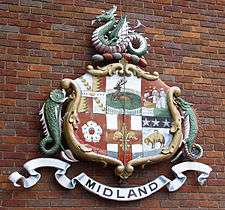 Arms of Midland Railway at Derby station, bearing in crest a wyvern sans legs
Arms of Midland Railway at Derby station, bearing in crest a wyvern sans legs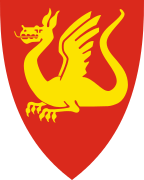 Municipal arms of Stjørdal, Norway
Municipal arms of Stjørdal, Norway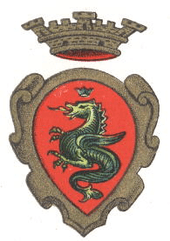 Municipal arms of Terni, Italy
Municipal arms of Terni, Italy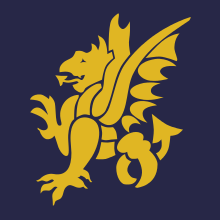 43rd (Wessex) Infantry Division insignia (World War II)
43rd (Wessex) Infantry Division insignia (World War II)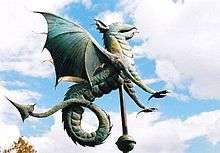 Wyvern weather vane
Wyvern weather vane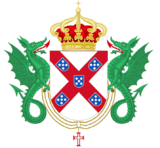 Wyverns as supporters in the coat of arms of the Portuguese House of Braganza
Wyverns as supporters in the coat of arms of the Portuguese House of Braganza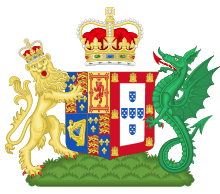 The arms of Catherine of Braganza, Queen consort of England, Scotland and Ireland and princess of Portugal, combines as supporters the wyvern vert of Portugal and the crowned lion of England.
The arms of Catherine of Braganza, Queen consort of England, Scotland and Ireland and princess of Portugal, combines as supporters the wyvern vert of Portugal and the crowned lion of England. US Army 3rd Infantry Division has a wyvern on its coat of arms. The insignia is worn as a unit crest by members of the division's command.
US Army 3rd Infantry Division has a wyvern on its coat of arms. The insignia is worn as a unit crest by members of the division's command.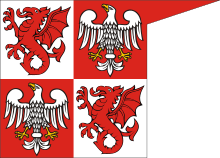 The flag of the former Duchy of Masovia
The flag of the former Duchy of Masovia_200x200.png) A partial ink printed on paper label removed from the back of a painting restored between 1820 and 1888 featured this wyvern symbol and the motto "Par sit fortuna labori" (let the success be equal to the labor), slogan of families Buchanan, Lowman, and Palmer, of which only Palmer has a Wyvern on their family crest, according to Burke's Peerage & Baronetage - all on the BBC show "Fake Or Fortune" S02E03 Anthony van Dyck.[18]
A partial ink printed on paper label removed from the back of a painting restored between 1820 and 1888 featured this wyvern symbol and the motto "Par sit fortuna labori" (let the success be equal to the labor), slogan of families Buchanan, Lowman, and Palmer, of which only Palmer has a Wyvern on their family crest, according to Burke's Peerage & Baronetage - all on the BBC show "Fake Or Fortune" S02E03 Anthony van Dyck.[18] With a wyvern atop the family crest of Palmer, Bt, of Carlton, in Burke's Peerage & Baronetage (likely 1999 edition), with the motto "Par sit fortuna labori" (let the success be equal to the labor).[19]
With a wyvern atop the family crest of Palmer, Bt, of Carlton, in Burke's Peerage & Baronetage (likely 1999 edition), with the motto "Par sit fortuna labori" (let the success be equal to the labor).[19]
See also
| Wikimedia Commons has media related to Wyverns. |
References
- https://en.oxforddictionaries.com/definition/wyvern/
- Hoad, T. F. (1993). English Etymology. Oxford: Oxford University Press. p. 546. ISBN 0-19-283098-8.
- "Oxford English Dictionary" (Second ed.). November 2010. Retrieved 2011-02-18.
- Sayers, William. "The Wyvern". Neuphilologische Mitteilungen 109.4 (2008): 457-465.
- "Flags in the Bayeux Tapestry". Encyclopædia Romana.
- https://www.visitwales.com/info/history-heritage-and-traditions/dragon-spirit-legend-welsh-dragon
- Valery Rees, From Gabriel to Lucifer: A Cultural History of Angels, I.B.Tauris, 19/03/2013
- Dennys, Rodney (1975). The Heraldic Imagination. New York: Clarkson N. Potter. pp. 186–8. ISBN 0517526298.
- Dungeons & Dragons Core Rulebook: Monster Manual. Wizards of the Coast. ISBN 978-0786965618.
- A wyvern and an elephant may be found at Harley MS 3244 (dated 13th century, after c. 1236), f.39v.
- Fox-Davies, Charles (October 4, 2019). A Complete Guide to Heraldry. London: T.C. & E.C. Jack. ISBN 9781858910796.
- Geoffrey Briggs, Civic & Corporate Heraldry, London 1971
C. W. Scot-Giles, Civic Heraldry of England and Wales, 2nd edition, London, 1953
A. C. Fox-Davies, The Book of Public Arms, London 1915 - Cuthbert Hamilton Ellis, The Midland Railway, 1953
- Frederick Smeeton Williams, The Midland Railway: Its rise and progress: A narrative of modern enterprise, 1876
The Railway Magazine, Vol. 102, 1897
Dow, George (1973). Railway Heraldry: and other insignia. Newton Abbot: David and Charles. ISBN 9780715358962.CS1 maint: ref=harv (link)
Clement Edwin Stretton, History of The Midland Railway, 1901 - The Railway Magazine, Vol. 102, 1897
- Leicestershire History: What is the Origin of the Leicester Wyvern?
- "51ST OPERATIONS SUPPORT SQUADRON > Osan Air Base > Display". www.osan.af.mil.
- mightwenotbehappy (2018-08-23). "Fake Or Fortune S02E03 Anthony van Dyck". YouTube. BBC. Retrieved 2020-07-15. Screen capture @ 40m (of 58:56), then unskewed, cropped, isolated, and contrast in Photoshop by User:JasonCarswell.
- mightwenotbehappy (2018-08-23). "Fake Or Fortune S02E03 Anthony van Dyck". YouTube. BBC. Retrieved 2020-07-15. Screen capture @ 40m (of 58:56).
External links
| Look up wyvern in Wiktionary, the free dictionary. |